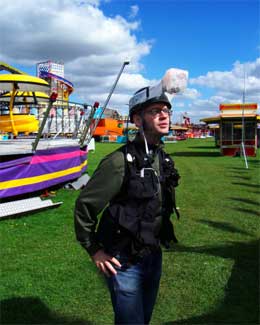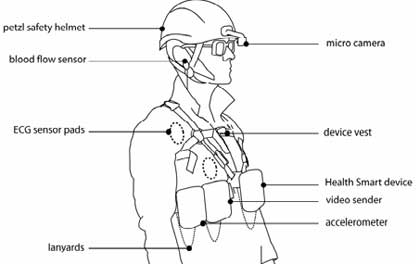 Brendan Walker, the “thrill engineer” (pictured on the left wearing the prototype equipment), is curating Thrill Laboratory, an exhibit which will open on October 17 at London’s Science Museum.
Brendan Walker, the “thrill engineer” (pictured on the left wearing the prototype equipment), is curating Thrill Laboratory, an exhibit which will open on October 17 at London’s Science Museum.
At the Thrill Lab, volunteers will be asked to try several fairground rides while hooked up to equipment that tracks their emotional state.
This includes an accelerometer that measures the G-force their body is subjected to and an ECG monitor that keeps track of their heart rate. In addition, a helmet-mounted camera will film their facial expressions as they ride the machine.
Information will be beamed in real time to a computer and the measurements will be reproduced on several public displays. Besides, physiologists and psychologists will discuss how thrill, anticipation and fear are affecting them.
“Eventually we hope to incorporate an adaptive element, to allow rides and computer games to react in real time according to the thrill levels being experienced,” explained Walker.
The Science Museum installation will include 3 different rides – the Booster, to measure the physiology of excitement and thrill; a ghost train, to measure fear and anticipation; and a ride called Miami Trip, a gentler ride designed to explore pleasure.
Steve Benford, of the mixed reality lab at the University of Nottingham, says it will enable people to better reflect on the experiences that generate their emotions. “We will be able to see if bio-signals reliably map onto the subjective experience of thrill,” commented Benford. “The key question is to understand the reliability and predictability of the thrill experience,” he says. The data can then be used as an analytical tool to design more-immersive rides and games, so-called “real-time adaptive spaces”, he says.
One of the first such interactive feedback experiences is a game Benford has helped develop, called ‘Ere Be Dragons. In this game, a player is hooked up to a heart sensor and a GPS device, and must walk through the real world while also exploring one created on a pocket PC.
 Illustration of Walker’s system
Illustration of Walker’s system
Via new scientist. Images courtesy of Brendan Walker.
